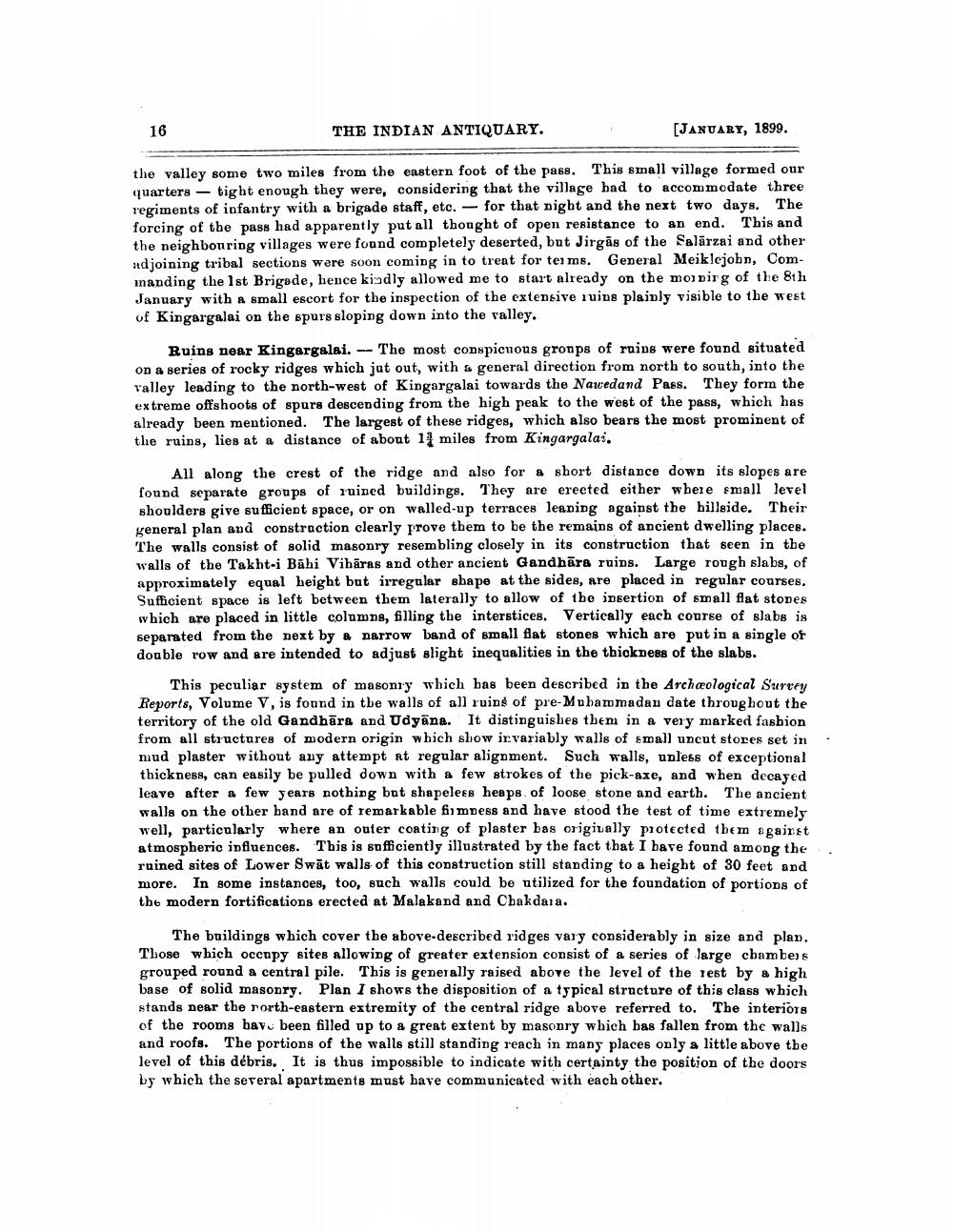________________
16
THE INDIAN ANTIQUARY.
(JANUARY, 1899.
the valley some two miles from the eastern foot of the pass. This small village formed our quarters - tight enough they were, considering that the village had to accommodate three regiments of infantry with a brigade staff, etc. --for that night and the next two days. The forcing of the pass had apparently put all thought of open resistance to an end. This and the neighbon ring villages were found completely deserted, but Jirgās of the Salārzai and other adjoining tribal sections were soon coming in to treat for terms. General Meiklejohn, Cominanding the 1st Brigade, hence kiadly allowed me to start already on the movirg of the 8th January with a small escort for the inspection of the extensive ruins plainly visible to the west of Kingargalai on the spurs sloping down into the valley.
Ruins near Kingargalai. --The most conspicuous gronps of ruins were found situated on a series of rocky ridges which jut out, with a general direction from north to south, into the valley leading to the north-west of Kingargalai towards the Nawedand Pass. They form the extreme offshoots of spurs descending from the high peak to the west of the pass, which has already been mentioned. The largest of these ridges, which also bears the most prominent of the ruins, lies at a distance of about 14 miles from Kingargalas.
All along the crest of the ridge and also for a short distance down its slopes are found separate groups of ruined buildings. They are erected either where small level shoulders give sufficient space, or on walled-up terraces leaning against the billside. Their general plan and construction clearly prove them to be the remains of ancient dwelling places. The walls consist of solid masonry resembling closely in its construction that seen in the walls of the Takht-i Bāhi Vibāras and other ancient Gandhāra ruins. Large rough slabs, of approximately equal height but irregular shape at the sides, are placed in regular courses. Sufficient space is left between them laterally to allow of the insertion of small flat stones which are placed in little columne, filling the interstices. Vertically each course of slabs is separated from the next by a narrow band of small flat stones which are put in a single or double row and are intended to adjust slight inequalities in the thickness of the slabs.
This peculiar system of masonry which has been described in the Archeological Survey Reports, Volume V, is found in tbe walls of all ruins of pre-Muhammadan date throughout the territory of the old Gandhāra and Udyana. It distinguishes them in a very marked fashion from all structures of modern origin which show ir variably walls of small uncut stores set in mud plaster without any attempt at regular aligoment. Such walls, unless of exceptional thickness, can easily be pulled down with a few strokes of the pick-axe, and when decayed leave after a few years nothing but shapelees heaps of loose stone and earth. The ancient walls on the other band are of remarkable fimress and have stood the test of time extremely well, particularly where an outer coating of plaster bas originally protected them against atmospheric influences. This is sufficiently illustrated by the fact that I have found among the ruined sites of Lower Swat walls of this construction still standing to a height of 30 feet and more. In some instances, too, such walls could be utilized for the foundation of portions of the modern fortifications erected at Malakand and Chakdara.
The buildings which cover the above described ridges vary considerably in size and plan. Those which occupy sites allowing of greater extension consist of a series of large chambers grouped round a central pile. This is generally raised above the level of the rest by a high base of solid masonry. Plan I shows the disposition of a typical structure of this class which stands near the rorth-eastern extremity of the central ridge above referred to. The interiors of the rooms have been filled up to a great extent by masonry which bas fallen from the walls and roofs. The portions of the walls still standing reach in many places only a little above the level of this débris. It is thus impossible to indicate with certainty the position of the doors by which the several apartments must bave communicated with each other.




